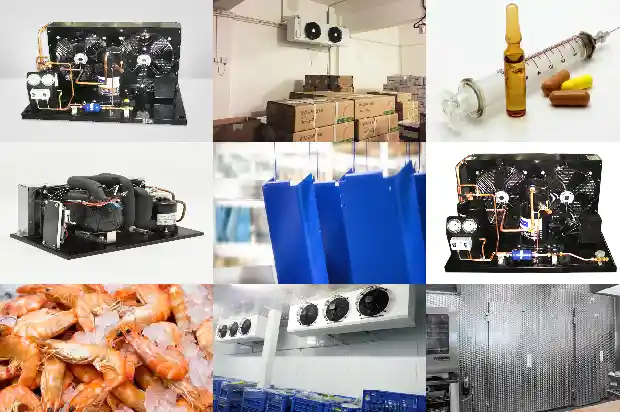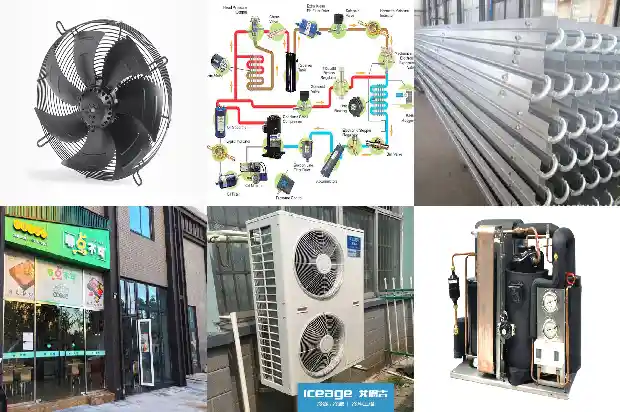Precautions for Commissioning of Screw Parallel Units
2025-02-16
For most screw parallel units produced by equipment manufacturers, lubricating oil is generally not pre - installed in the oil separator of the unit before leaving the factory. Therefore, after the installation of the screw parallel unit (positioning, pipeline connection, electrical connection) is completed, it is necessary to conduct a leak check on the system, add lubricating oil, then evacuate the system, add refrigerant, and confirm that there are no leakage points in the system before commissioning.
I. Pressure and Leakage Test
Close the valves in the refrigeration unit that communicate with the external environment. Inject dry nitrogen into the system. When the system pressure reaches 10 - 15 bar, stop filling nitrogen. Use soapy water to check for leaks at all welded parts, threaded connections, valve connections, etc. Then, keep the pressure in the system for 24 hours. If the pressure remains basically unchanged, it indicates that the system has good sealing performance, and the nitrogen used for pressure - holding can be released.
II. Adding Lubricating Oil
It is necessary to use the lubricating oil specified by the compressor manufacturer. First, open all the valves on the oil circuit.
The container for storing lubricating oil must be a sealed container to prevent the lubricating oil from absorbing moisture from the environment.

The container for storing lubricating oil must be a sealed container to prevent the lubricating oil from absorbing moisture from the environment.
III. Vacuuming
Before vacuuming, install all the dryer - filter cores. Turn on the oil heater (set at 40 - 45 °C). Close the valves connecting the system to the atmosphere and open the valves between the unit and other equipment. In most cases, there is a refrigerant - charging valve (liquid - charging valve) near the dryer - filter. Connect the pipeline of the vacuum pump from this place. Generally, it is not allowed to use the unit itself to vacuum.

IV. Refrigerant Charging
After vacuuming, refrigerant can be added from the liquid - charging valve in front of the dryer - filter. The size and model of other equipment in the system (such as evaporators, condensers, receivers, etc.) will affect the refrigerant charging amount. It can be charged according to the theoretical calculation amount first.
The theoretical calculation amount is the volume of each equipment multiplied by its volume coefficient and then multiplied by the refrigerant density. For example, the volume coefficient of the evaporative condenser is 20%; the volume coefficient of the liquid pipe is 100%; the volume coefficient of the receiver is 70%, etc. Charge according to the refrigerant model and recommended charging amount required by the manufacturer.
The theoretical calculation amount is the volume of each equipment multiplied by its volume coefficient and then multiplied by the refrigerant density. For example, the volume coefficient of the evaporative condenser is 20%; the volume coefficient of the liquid pipe is 100%; the volume coefficient of the receiver is 70%, etc. Charge according to the refrigerant model and recommended charging amount required by the manufacturer.
V. Test - Run Before Formal Start - up
Before starting the unit, check that the valves between the unit and the condenser, as well as those on the oil and gas circuits, are open. However, for solenoid valves and the automatic protection settings of the unit, check the factory settings and do not open or close them casually to avoid misoperation. In addition, the following points need attention:
a) Check that the oil level in the oil separator should be at the mid - line position of the oil - sight glass.
b) The circuit breaker on the compressor should be in the open state. If the compressor uses split - coil starting, it is also necessary to verify the delay time of split - coil starting.
c) Check the rotation direction of the compressor one by one. For open - type compressors, check whether the rotation direction is consistent with the arrow direction on the compressor head. For semi - hermetic compressors, if a head protection device is installed, the protection device will give an alarm when the rotation direction is incorrect. If no alarm device is installed, connect a barometer to the suction valve of the compressor, close the suction valve completely, and then open it only one turn. If the rotation direction is correct, the pressure indicated by the barometer will drop immediately. If the barometer value rises, it indicates that the rotation direction is incorrect and should be adjusted immediately.
a) Check that the oil level in the oil separator should be at the mid - line position of the oil - sight glass.
b) The circuit breaker on the compressor should be in the open state. If the compressor uses split - coil starting, it is also necessary to verify the delay time of split - coil starting.
c) Check the rotation direction of the compressor one by one. For open - type compressors, check whether the rotation direction is consistent with the arrow direction on the compressor head. For semi - hermetic compressors, if a head protection device is installed, the protection device will give an alarm when the rotation direction is incorrect. If no alarm device is installed, connect a barometer to the suction valve of the compressor, close the suction valve completely, and then open it only one turn. If the rotation direction is correct, the pressure indicated by the barometer will drop immediately. If the barometer value rises, it indicates that the rotation direction is incorrect and should be adjusted immediately.
VI. Precautions for Starting and Operation
Close the suction valve of the compressor. Start the compressor and slowly open the suction valve. Observe the oil - sight glass. If no oil flow is seen within five seconds, stop the operation of the compressor immediately. Pay attention to the following key points:
a) Check whether the voltage and current are consistent with the parameters on the nameplate of the compressor unit.
b) During operation, a large amount of foam may be generated in the oil separator, but under normal circumstances, it will gradually disappear in about five minutes. If it does not disappear, measures should be taken.
c) For the adjustment of the oil - cooling temperature, during normal use, the oil temperature should be ensured to be 20K - 30K higher than the condensing temperature, and the oil temperature generally should not exceed 80 °C.
d) Pay attention to observing the pressure and temperature changes of the system, including the parameter changes of the condenser, evaporator, etc.
a) Check whether the voltage and current are consistent with the parameters on the nameplate of the compressor unit.
b) During operation, a large amount of foam may be generated in the oil separator, but under normal circumstances, it will gradually disappear in about five minutes. If it does not disappear, measures should be taken.
c) For the adjustment of the oil - cooling temperature, during normal use, the oil temperature should be ensured to be 20K - 30K higher than the condensing temperature, and the oil temperature generally should not exceed 80 °C.
d) Pay attention to observing the pressure and temperature changes of the system, including the parameter changes of the condenser, evaporator, etc.
Related Articles
- Precautions for Using Rotary Refrigeration Compressors
- Four Combustible and Explosive Refrigerants: Precautions When in Use!
- Accident Handling and Precautions for Circulating Water Pumps
- What Precautions Should Be Taken When Using a Fresh - keeping Cold Storage in Summer?
- Operations and Precautions for Multi - split Air Conditioners: Blowing Debris, Air Tightness, Vacuum Drying, and Refrigerant Charging
- Precautions for the Installation and Use of Water Flow Switches
- Precautions for the Hot Gas Bypass Valve of Refrigeration Units in Cold Storage
- Precautions for Inspecting Valves in Refrigeration Systems
- Parallel Installation and Precautions for Scroll Compressors
- Installation and Oil Return Precautions for Refrigeration Equipment Pipelines
- Precautions for Replacing Refrigeration Compressor Refrigerant Oil
- Precautions for Cold Storage Design
- Composition and Common Faults of Screw Refrigeration Compressors
- Operation of Screw - type Water - cooled Chiller Units
- What Are the Reasons for Insufficient Air Output of Screw Air Compressors?
- How to Schedule Overhauls, Medium - sized and Minor Repairs of Screw Refrigeration Compressors?
- Maintenance Methods for Faults in Screw Refrigeration Air - conditioner Compressors
- Reference Points for Selection of Screw - type Chillers
